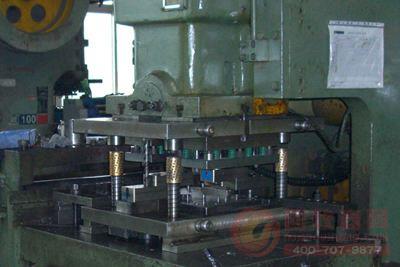
Stamping is a method of forming a workpiece (stamping part) of a desired shape and size by applying an external force to a plate, a strip, a pipe, a profile, and the like by a press and a die to cause plastic deformation or separation. Stamping and forging are the same plastic processing (or pressure processing), collectively called forging. The stamped blanks are mainly hot rolled and cold rolled steel sheets and strips.
Of the world's steel, 60 to 70% are sheets, most of which are stamped into finished products. The body, chassis, fuel tank, radiator plate of the automobile, the steam drum of the boiler, the casing of the container, the iron core silicon steel of the electric motor and the electric appliance are all stamped and processed. There are also a large number of stamping parts in instruments, household appliances, bicycles, office machinery, living utensils and other products.
Compared with castings and forgings, stamping parts are thin, uniform, light and strong. Stamping can produce workpieces with ribs, ribs, undulations or flanging that are difficult to manufacture by other methods to increase their rigidity. Thanks to the use of precision molds, the precision of the workpiece can reach micron level, and the repeatability is high and the specifications are the same, and the holes, bosses and the like can be punched out.
Cold stampings are generally no longer machined or require only a small amount of machining. The precision and surface condition of hot stampings are lower than that of cold stampings, but they are still superior to castings and forgings, and the amount of cutting is small.
Stamping is an efficient production method. It adopts composite molds, especially multi-station progressive molds. It can complete multiple stamping processes on one press, and realize the whole process of unwinding, leveling and punching to forming and finishing. Automatic production. High production efficiency, good working conditions, low production costs, and generally can produce hundreds of pieces per minute.
Stamping is mainly classified according to the process and can be divided into two major categories: separation process and forming process. The separation process is also called punching, and its purpose is to separate the stampings from the sheet along a certain contour line, while ensuring the quality requirements of the separated sections. The purpose of the forming process is to plastically deform the sheet without breaking the blank to produce a workpiece of the desired shape and size. In actual production, it is often the case that multiple processes are integrated into one workpiece. Blanking, bending, shearing, drawing, bulging, spinning, and correction are several major stamping processes.
The surface and intrinsic properties of stamping sheets have a great influence on the quality of stamped products. The thickness of stamping materials is required to be precise and uniform. The surface is smooth, no spots, no flaws, no scratches, no surface cracks, etc.; yield strength is uniform, no obvious Directionality; high uniform elongation; low yield ratio; low work hardenability.
In actual production, the process test similar to the stamping process, such as the drawing performance test and the bulging performance test, is used to test the punching performance of the material to ensure the quality of the finished product and high qualification rate.
The precision and structure of the mold directly affects the forming and precision of the stamping. Mold manufacturing cost and life are important factors affecting the cost and quality of stamping parts. Mold design and manufacturing require more time, which extends the production lead time for new stampings.
Standardization of mold bases, formwork, guides and development of simple molds (for small batch production), composite molds, multi-station progressive molds (for mass production), and the development of rapid mold change devices to reduce the workload of stamping production preparation And shortening the preparation time, it can be applied to reduce the workload of press production preparation and shorten the preparation time, and the advanced stamping technology suitable for mass production can be reasonably applied to small batch and multi-variety production.
In addition to the forming of the heavy plate water press, the stamping equipment generally uses a mechanical press. Centered on modern high-speed multi-station mechanical presses, equipped with unwinding, leveling, finished product collection, conveying and other machinery as well as mold libraries and rapid mold change devices, and using computer program control, can form a high-productivity automatic stamping production line.
In the case of producing dozens or hundreds of stamping parts per minute, the processes of feeding, stamping, discharging, discharging waste, etc. are completed in a short time, and personal, equipment and quality accidents often occur. Therefore, safe production in stamping is a very important issue.
Hook And Loop Film Sanding Disc, Customized Film Sanding Disc, Dry Wet Film Sanding Disc
Foshan Nate Abrasive Science & Technology Co.,Ltd , https://www.nateabrasives.com